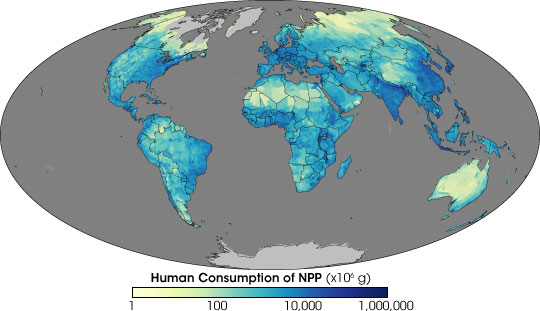

|
Our lives depend on plants. Plants turn the energy of the Sun into our most basic needs: lumber for houses, fuel for cooking, fiber for clothing, feed for livestock, and food for our own growing bodies. But as global population and incomes rise, will plants be able to keep up with the human appetite? And if they cannot, which regions will be short on food and other plant-based resources, and what will that mean for nations as they try to assure food security for their citizens? Marc Imhoff, a biophysical scientist with NASA, has been exploring these questions with colleagues from the University of Maryland’s Earth System Science Interdisciplinary Center, the World Wildlife Fund, and the International Food Policy Research Institute for six years. He said, “Our primary motivation has been to find out where we stand relative to our survival on the planet, and what our needs are compared to the capability of the biosphere to sustain them. In fact, it goes beyond just need; it includes our different lifestyles—our appetites.” To build some answers, Imhoff set about measuring global plant productivity, calculating human consumption levels on a cultural level, and then comparing what he learned. His findings remind us that we all rely on the same finite Earth. The Green SupplyNet primary production is a measure of plant productivity, the amount of plant material left over after respiration. Imhoff put it this way: “Net primary production is the plant material that we see above ground, as well as what is below ground, like root systems. All of our food, much of our fiber, and for many people in developing countries fuel for cooking, is derived from plant material.” |
Adapted from an article published by Earth System Science Data and Services. | ||
 | |||
|
To measure net primary production, Imhoff used an index, or scale, of vegetation based on satellite data from the Advanced Very High Resolution Radiometer (AVHRR) instrument. The satellite observations spanned every sixteen-day period from 1982 to 1998, allowing Imhoff to compute an average maximum vegetation amount for each month of the year. He combined the monthly vegetation data with temperature, humidity, rainfall, and land cover type in a model that simulates plant growth. The model provided Imhoff and his colleagues an estimate of the planet’s net primary production. Imhoff said, “This information gave us the planetary supply of plant production on land that is available to humans in an average year.” The Human AppetiteImhoff’s next step was to measure the amount of net primary production that humans use worldwide in an average year, and then tie it to cultural consumption habits. To do that, he turned to statistics from the United Nations Food and Agricultural Organization (FAO) on food and fiber consumption by country, taking the data from 1995 as a typical year that matched the satellite timeline. He said, “We divided the consumption statistics into food, both plant- and animal-derived; and fiber, including wood, wood-based fuel, and paper. Then, we backed out what you would need to see in the field to get those products,” he said. “This way, we could double-check what the AVHRR data would have shown in the field with what the consumption statistics indicated was actually used.” |
The first step in measuring plants’ ability to sustain the human population is to measure Earth’s annual net primary production, the amount of plant matter an ecosystem produces. This image, based on observations of vegetation from satellites, shows productivity on a scale from 0 to 2 trillion grams. Dark green areas indicate the most productive areas, and beige indicates the least productive. (Image by Jesse Allen, based on data from NASA’s Socioeconomic Data Center.) | ||
 | |||
|
Next, Imhoff requested data on global population numbers and density from NASA’s Socioeconomic Data and Applications Center. “We overlaid the consumption data on the population map and ended up with a gridded surface map showing the amount of net primary production required to support the consumption habits of different human populations all over the world.” This map gave Imhoff the information he needed to compare nature’s supply of plant production with human demand. |
People everywhere depend on Earth's net primary production (NPP) for everything from food to clothing to fuel. This figure shows how much (millions of grams) of the Earth's NPP people in different parts of the world consume. High national consumption can be due to large populations with low per-person consumption levels (e.g., India), or to small populations (United States, European countries) with high per-person consumption levels. (Image by Jesse Allen, based on data from NASA’s Socioeconomic Data Center.) | ||